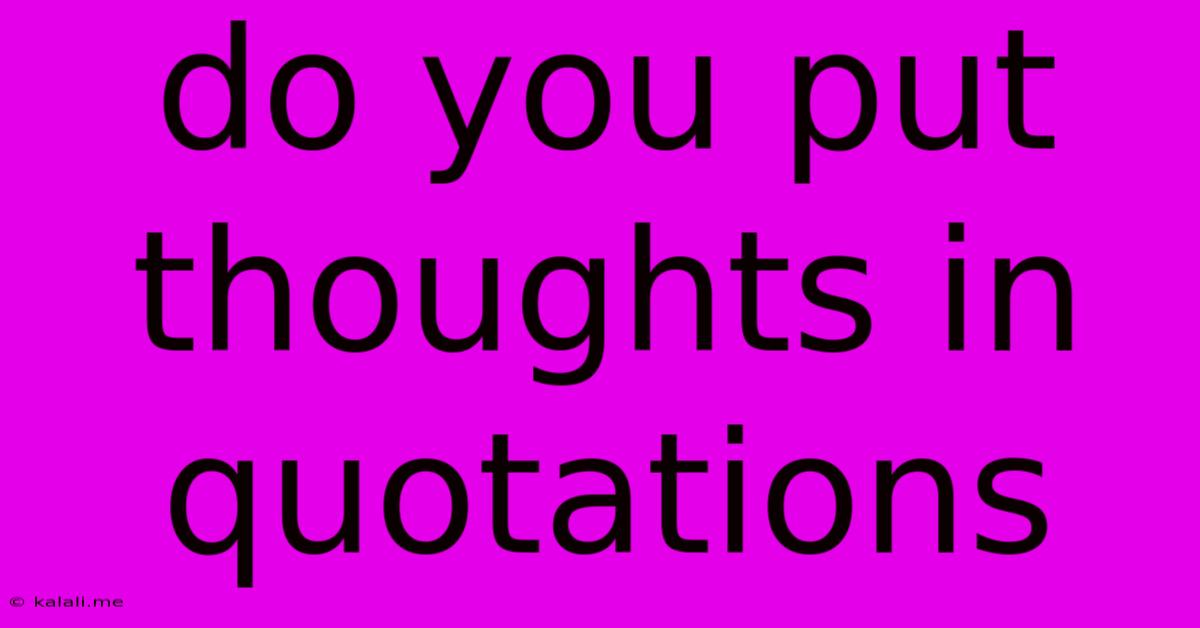Do You Put Thoughts In Quotations
Kalali
May 25, 2025 · 3 min read

Table of Contents
Do You Put Thoughts in Quotation Marks? A Guide to Punctuating Internal Dialogue
Do you put thoughts in quotation marks? The answer isn't a simple yes or no. The punctuation of internal dialogue, or the thoughts and feelings of a character, depends on your writing style and the effect you want to achieve. This guide will clarify the rules and nuances of punctuating internal thoughts in your writing, helping you to craft compelling and grammatically correct narratives.
Whether you're a novelist crafting intricate character studies or a short story writer aiming for concise prose, mastering internal dialogue punctuation is crucial for effective storytelling. This article will explore the different approaches, outlining when to use quotation marks and when to avoid them, ultimately enhancing the clarity and impact of your writing.
When to Use Quotation Marks for Thoughts
Generally, quotation marks are used for direct internal dialogue—thoughts that are clearly articulated in the character's mind, similar to spoken words. Think of it like the character is having a conversation with themselves.
- Example: “I shouldn’t have eaten that whole cake,” she thought, groaning inwardly.
In this example, the thought is presented as a complete sentence, mirroring how someone might speak it aloud. The quotation marks clearly delineate the thought from the narrative itself. This method is particularly effective for emphasizing the character's self-awareness and inner voice. It can also create a dramatic effect, highlighting the intensity of their thought process.
When NOT to Use Quotation Marks for Thoughts
There are several scenarios where quotation marks are unnecessary and even stylistically jarring when representing internal thoughts.
-
Free indirect discourse: This technique blends the narrator's voice with the character's thoughts, creating a seamless flow of consciousness. No quotation marks are needed because the thoughts are presented implicitly.
-
Example: She wondered if she should have eaten that whole cake. The sugar rush was making her head spin.
Here, the character's thought is conveyed indirectly through the narrative, creating a more subtle and integrated effect. It's a stylistic choice that fosters a close connection between the reader and the character's inner world.
-
Summary of thoughts: When summarizing a character's thoughts rather than presenting them verbatim, quotation marks are generally not used.
-
Example: She considered the implications of her actions, regretting her impulsive decision.
This approach is more concise and focuses on the overall effect of the thoughts rather than their specific wording. It's especially useful for pacing and preventing the narrative from becoming bogged down in internal monologue.
Choosing the Right Approach: Style and Context
The decision of whether or not to use quotation marks for thoughts often boils down to personal style and the specific context of your writing. Consider:
- The level of detail: Do you want to present the character's thoughts precisely, or is a more generalized summary sufficient?
- The tone and mood: Quotation marks can create a more dramatic or emphatic tone, whereas omitting them can achieve a sense of subtlety and intimacy.
- The overall pacing of your narrative: Overuse of quotation marks for internal thoughts can interrupt the flow of the story.
Experiment with different approaches to find what best suits your writing style and the specific needs of your story. Remember that consistency is key; choose a method and stick to it throughout your work to avoid confusing the reader.
Mastering Internal Monologue: A Key to Compelling Storytelling
Ultimately, the effective use of internal monologue is a significant tool in the writer's arsenal. Whether you choose to use quotation marks or not, remember that clear and consistent punctuation is essential for creating a believable and engaging character, enhancing the overall impact of your storytelling. By understanding the nuances of punctuating internal dialogue, you can craft stories that resonate with readers on a deeper level.
Latest Posts
Latest Posts
-
Applescript Preview Save All Open Windows
May 25, 2025
-
Pilot Light Wont Stay Lit When I Release The Knob
May 25, 2025
-
How Do I Change From Text To Imessage
May 25, 2025
-
How Do You Say Of In Japanese
May 25, 2025
-
Why Is Ccd Less Susceptible To Noise
May 25, 2025
Related Post
Thank you for visiting our website which covers about Do You Put Thoughts In Quotations . We hope the information provided has been useful to you. Feel free to contact us if you have any questions or need further assistance. See you next time and don't miss to bookmark.